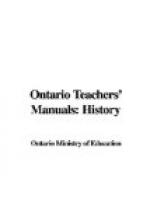The excellence of this work lies in its review and repetition. The old or former knowledge is recalled and used in each succeeding discussion of the topic. The pupils grow gradually into fuller knowledge.
3. Methods based on class procedure: Oral, Text-book
THE ORAL METHOD
This usually takes the form of an oral presentation of the story or description of the event by the teacher, while the pupils listen and afterwards reproduce what they have heard. The narration of the story is accompanied by pictures, sketches, maps, etc., illustrative of persons, places, and facts mentioned. It may also take the “development” form, in which a combination of narrative and questioning is employed. (See pp. 66, 92.)
The Lecture method of Colleges and Universities is an advanced oral method. In this the teacher narrates and describes events, propounds questions, and discusses and answers them himself, while the pupils listen and during the lecture, or afterwards, make notes of what has been heard.
THE TEXT-BOOK METHOD
By this method the teacher assigns a lesson in the book and, after the pupils have an opportunity to study it, he asks questions concerning the facts learned. The exclusive use of this method results ordinarily in dull, lifeless teaching, and with junior pupils will prevent their enjoying, or receiving much benefit from, the study of history. There are two reasons for the too general use of it—first, it is an easy method for the teacher, and secondly, it is easy for the pupils to memorize facts for the sole purpose of passing examinations. While this criticism is true when an exclusive use is made of the text-book, the same cannot be said when the text-book is used as an auxiliary to the teacher. Following the oral presentation of the story, reference may be made to the book for another version or for a fuller account and, in Form IV, topics may be assigned and the pupils directed to consult the text-book for the necessary information. (See pp. 26, 28.)
The text-book should be one that does not show an abrupt change from the story told by the teacher. It should not be merely a short outline of the important facts in history, written separately and then pieced together in chronological order, but should be written in a readable form by one who is able to distinguish the important and necessary from the unimportant and burdensome. It should have short summaries at the ends of chapters or stories of events, so that a grasp of what has been read may be easily obtained. It should also have many pictures, illustrations, and maps, to take the place of the teacher’s explanations in the earlier stage. (On the use of the text-book, see p. 29.)




